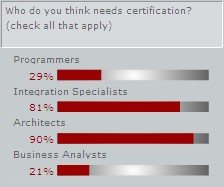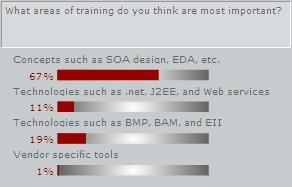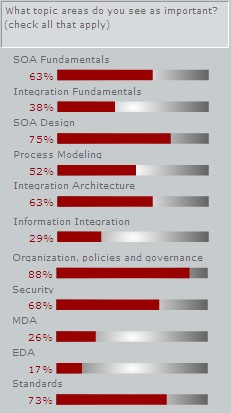An article by Bruce Silver in Intelligent Enterprise discusses the recent spate of BPM vendors releasing their process modelling tools for free. He lists Savvion, Oracle and Intalio, but the trend is widening — TIBCO just announced the availability of their modeling tool, and although the press release doesn’t specify, I heard a rumour that it’s free as well (how could it not be, considering the competition?). These offerings, from companies who make their money on the BPMS engine side so can afford to give away the modelling tools, will certainly make a dent in the market share of some of the dedicated modelling tools, such as Proforma, although many of the dedicated tools provide more extensive enterprise architecture-type modelling, not just process modelling.
One significant problem with these free tools is that although the vendors assume that they will just spread to all the desktops in an organization like wildfire, most corporate IT departments lock down user desktop configurations so that you can’t install applications. Although this might seem like a bit of Big Brother, there’s a good reason for this: it’s completely impossible for a corporate IT department to support several thousand PCs if the users can just install anything that they want on them. A case in point: a few years ago, a workstation at a client of mine started freezing “randomly”, which they blamed on the BPM software that we had installed on it. After several service calls where the problem did not recur, followed by uninstalls and reinstalls, one of my engineers finally just hung around until the problem occurred. The culprit? A non-corporate-standard screen saver that showed an animated football game; the machine hung right around the first down when the cheerleaders came out. When we reverted to a standard Windows screen saver, the problem disappeared. Since then, I’ve never complained about the restrictions that corporate IT makes on standard user desktops, even though it keeps me from using Firefox at most customer sites.
What this means is that even if a vendor makes their software available for free, that doesn’t assure acceptance, because it’s not free for an organization to regression test that against their standard desktop environment(s) and all of the other applications with which it might coexist. There’s two possible solutions to this:
- Create an entirely web-based process modelling tool. (Do BPMS vendors know about Web 2.0 yet?)
- Use a modelling tool that is already on most users’ desktops, namely Microsoft Visio.
I had a chat with one of the BPMS vendors recently about the first option, and he asked if I felt that web-based was the way to go (I love it when BPMS vendors ask me my opinion on product direction 🙂 ). My reply:
I like web-based since it lowers the barrier to use… many people of the type that I see in my customers who are doing process modelling are doing so at their office location and could be doing it much more easily if they don’t have to get permission from their IT department to install something on their PC, but use a purely web-based tool.
We also discussed how an installed version was necessary for people who aren’t always connected, but most real process modellers aren’t doing it from 35,000 feet or at a trade show, they’re doing it from their desk with a high-speed corporate internet connection. Yes, you have to have something for the road warriors and your sales people, but ultimately you’ll be most successful if you build what’s best for the target audience.
Which brings me to the second solution: Visio. Last year, Bruce Silver had a couple of articles on using Visio for process modelling, referencing the itp-commerce product. I just had a demo of a competing product, Byzio from Zynium (which sounds like a fictional space alien and his planet, sort of like Mork from Ork), another Visio add-on that allows for more robust process modelling in that ubiquitous tool. Yes, you still need to install the add-on, but chances are that a corporate IT department will find it much easier to approve a Visio add-on for installation than a full application.
Basically, Byzio allows you to draw a process model in Visio, then export it to XPDL for import into a BPMS’ process modelling tool. [In case you’re not up on XPDL, it’s an XML file format used to store BPMN; BPMN is the graphic modelling notation.] You can use a BPMN stencil in Visio so that you’re using the standard BPMN shapes, but the real power of Byzio is in the ability to map from any shape to a BPMN/XPDL construct, so if you already have a corporate standard for what shapes to use in a process model, you don’t have to change that, you just have to set up the mapping. The really cool thing is that Byzio has the ability to use the text within a shape to assist in the mapping, for example, detecting the words “and” or “or” in a decision shape and choosing the correct decision type. The mapping setup, which includes a regular expression parser, is not something that you’ll want every user to be playing around with, but as long as everyone in a department is using some standard notation, you should be able to set up the mapping once and replicate it around.
Although XPDL is supposed to be a standard, every BPMS vendor has their own flavour of XPDL, so the Byzio installation has to be specific to the target BPMS: the version that was demonstrated for me was for Fujitsu Interstage, but they also list Appian and DST on their website and I know that there are others in the works. In the case of Interstage, after the XPDL file is exported from Visio using the Byzio add-on, it’s opened in the Interstage process designer, where it can be further enhanced with engine-specific parameters. Byzio also plans to support round-tripping, where the XPDL can be exported back from the BPMS process designer for import into Visio for rework — I think that there’s some serious challenges in making this happen, but it’s doable. Not as integrated as using the BPMS’ process designer directly, but it has the huge advantage of using software that’s already installed on every business analysts’ desktop.
I’m still torn on the best solution in the long run. I feel strongly that there’s a place for BPMS vendors to create fully web-based versions of their process modelling tools intended for use by business users: namely, versions of the tools that don’t include all the yucky technical details, but provide a business view of the process models as they exist in the BPMS — no importing/exporting required. However, Visio is used for so much more than just what’s going to be automated in a BPMS that it will retain its dominance in process modelling by business users for the foreseeable future. That being said, I’ll give the edge to Visio paired with add-ons such as Byzio or itp-commerce.



